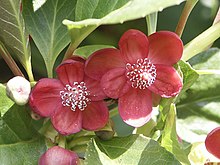Schisandra: Difference between revisions
m Bot: Migrating 9 interwiki links, now provided by Wikidata on d:q1277423 (Report Errors) |
No edit summary Tag: gettingstarted edit |
||
| Line 13: | Line 13: | ||
*''[[Schisandra glabra]]'' |
*''[[Schisandra glabra]]'' |
||
}} |
}} |
||
'''''Schisandra''''' (Magnolia Vine) is a [[genus]] of [[shrub]] commonly grown in gardens. It is a hardy [[deciduous]] [[climbing plant|climber]] which thrives in |
'''''Schisandra''''' (Magnolia Vine) is a [[genus]] of [[shrub]] commonly grown in gardens. It is a hardy [[deciduous]] [[climbing plant|climber]] which thrives in almost any kind of [[soil]]; its preferred position is on a sheltered, shady wall. It may be [[plant propagation|propagated]] by [[cutting]] off half-matured [[shoot]]s in August. Species include: ''[[Schisandra chinensis|S. chinensis]]'', ''S. glaucescens'', ''S. rubriflora'' and ''S. rubrifolia''. |
||
==Description== |
==Description== |
||
[[File:Schisandra rubriflora.jpg|thumb|left|Flowers of [[Schisandra rubriflora]] at [[Royal Botanic Gardens, Kew|Royal Botanic Gardens]], Kew, UK]] |
[[File:Schisandra rubriflora.jpg|thumb|left|Flowers of [[Schisandra rubriflora]] at [[Royal Botanic Gardens, Kew|Royal Botanic Gardens]], Kew, UK]] |
||
''Schisandra'' is native to [[East Asia]], and its dried [[fruit]] is used medicinally. The [[berry|berries]] of ''S. chinensis'' are given the name ''wu wei zi'' in Chinese ([[wiktionary:五|五]][[wiktionary:味|味]][[wiktionary:子|子]]; pinyin: wǔ wèi zi), which translates as "five flavor fruit" because they possess all five basic flavors in Chinese herbal medicine: salty, sweet, sour, pungent (spicy), and bitter. In [[traditional Chinese medicine]] it is used as a remedy for many ailments: to resist infections, increase skin health, and combat insomnia, coughing, and thirst{{Citation needed|date=April 2011}}. |
''Schisandra'' is native to [[East Asia]], and its dried [[fruit]] is sometimes used medicinally. The [[berry|berries]] of ''S. chinensis'' are given the name ''wu wei zi'' in Chinese ([[wiktionary:五|五]][[wiktionary:味|味]][[wiktionary:子|子]]; pinyin: wǔ wèi zi), which translates as "five flavor fruit" because they possess all five basic flavors in Chinese herbal medicine: salty, sweet, sour, pungent (spicy), and bitter. In [[traditional Chinese medicine]] it is used as a remedy for many ailments: to resist infections, increase skin health, and combat insomnia, coughing, and thirst{{Citation needed|date=April 2011}}. |
||
==Species== |
==Species== |
||
Revision as of 22:43, 10 April 2013
| Schisandra | |
|---|---|

| |
| Scientific classification | |
| Kingdom: | |
| (unranked): | |
| Order: | |
| Family: | |
| Genus: | Schisandra
|
| Species | |
Schisandra (Magnolia Vine) is a genus of shrub commonly grown in gardens. It is a hardy deciduous climber which thrives in almost any kind of soil; its preferred position is on a sheltered, shady wall. It may be propagated by cutting off half-matured shoots in August. Species include: S. chinensis, S. glaucescens, S. rubriflora and S. rubrifolia.
Description

Schisandra is native to East Asia, and its dried fruit is sometimes used medicinally. The berries of S. chinensis are given the name wu wei zi in Chinese (五味子; pinyin: wǔ wèi zi), which translates as "five flavor fruit" because they possess all five basic flavors in Chinese herbal medicine: salty, sweet, sour, pungent (spicy), and bitter. In traditional Chinese medicine it is used as a remedy for many ailments: to resist infections, increase skin health, and combat insomnia, coughing, and thirst[citation needed].
Species
Over 19 species of the genus are said to be used in Chinese medicine, mostly as sedatives and tonic agents.
Pharmacology
Two human trials in China (one double-blind and the other preliminary) have shown that Schisandra[vague] may help people with chronic viral hepatitis reports Liu KT from Studies on fructus Schizandre cinensis.[citation needed] Schisandra lignans appear to protect the liver by activating the enzymes that produce glutathione.[citation needed]
Recently, the extract of S. rubriflora, a native of the Yunnan province, was found to contain complex and highly oxygenated nortriterpenoids called rubriflorins A-C. [1]
See also
References
- ^ Xiao, W.-L. et al.. J. Nat. Prod. 2007, Web release : May 10th.
External links
- Panossian A., Wikman G. Pharmacology of Schisandra chinensis Bail.: An overview of Russian research and uses in medicine . Journal of Ethnopharmacology. Vol 118/2 pp 183-212. doi:10.1016/j.jep.2008.04.020
- Schisandraceae [sensu stricto] in the Flora of North America
